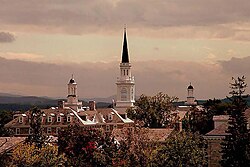Middlebury College
 From Wikipedia - Reading time: 29 min
From Wikipedia - Reading time: 29 min
This article has multiple issues. Please help improve it or discuss these issues on the talk page. (Learn how and when to remove these messages)
|
 | |
| Latin: Collegium Medioburiense Viridis Montis[1] | |
| Motto | Scientia et Virtus (Latin) |
|---|---|
Motto in English | Knowledge and Virtue |
| Type | Private liberal arts college |
| Established | November 1, 1800 |
| Accreditation | NECHE |
Academic affiliations | |
| Endowment | $1.47 billion (2022)[2] |
| President | Laurie L. Patton |
Academic staff | 377 (2021)[3] |
| Undergraduates | 2,773 (2022)[4] |
| Location | , , United States 44°00′32″N 73°10′38″W / 44.00889°N 73.17722°W |
| Campus | Rural, 350 acres (140 ha) |
| Colors | Blue and White [5] |
| Nickname | Panthers |
Sporting affiliations | |
| Mascot | Panther |
| Website | www |
 | |
Middlebury College is a private liberal arts college in Middlebury, Vermont. Founded in 1800 by Congregationalists, Middlebury was the first operating college or university in Vermont.[6]
In the fall of 2020, the college enrolled 2,773 undergraduates from all 50 states and 74 countries and offers 45 majors in the arts and humanities as well as joint engineering programs.[7] In addition to its undergraduate liberal arts program, the school also has graduate schools, the Middlebury College Language Schools, the Bread Loaf School of English, and the Middlebury Institute of International Studies at Monterey, as well as its C.V. Starr-Middlebury Schools Abroad international programs. Middlebury's 31 varsity teams are the Middlebury Panthers and compete in the NCAA Division III's NESCAC.
History
[edit]19th century
[edit]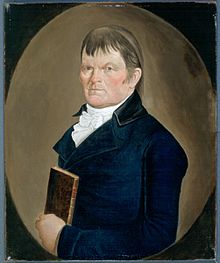

Middlebury received its founding charter on November 1, 1800, as an outgrowth of the Addison County Grammar School, which had been founded three years earlier in 1797. The college's first president—Jeremiah Atwater—began classes a few days later, making Middlebury the first operating college or university in Vermont.[6] One student named Aaron Petty graduated at the first commencement held in August 1802.[8] The college's founding religious affiliation was loosely Congregationalist. Yet the idea for a college was that of town fathers rather than clergymen, and Middlebury was clearly "the Town's College" rather than the Church's. Chief among its founders were Seth Storrs and Gamaliel Painter, the former credited with the idea for a college[9] and the latter as its greatest early benefactor. In addition to receiving a diploma upon graduation, Middlebury graduates also receive a replica of Gamaliel Painter's cane. Painter bequeathed his original cane to the college and it is carried by the college President at official occasions including first-year convocation and graduation. Alexander Twilight, class of 1823, was the first black graduate of any college or university in the United States; he also became the first African American elected to public office, joining the Vermont House of Representatives in 1836. At its second commencement in 1804, Middlebury granted Lemuel Haynes an honorary master's degree, the first advanced degree ever bestowed upon an African American.[10][11]
In 1883, the trustees voted to accept women as students in the college, making Middlebury one of the first formerly all-male liberal arts colleges in New England to become a coeducational institution. The first female graduate—May Belle Chellis—received her degree in 1886.[12] As valedictorian of the class of 1899, Mary Annette Anderson became the first African-American woman elected to Phi Beta Kappa.
20th century
[edit]The college's centennial in 1900 began a century of physical expansion beyond the three buildings of Old Stone Row. York and Sawyer designed the Egbert Starr Library (1900), a Beaux-Arts edifice later expanded and renamed the Axinn Center, and Warner Hall (1901). Growth in enrollment and the endowment led to continued expansion westward. McCullough Hall (1912) and Voter Hall (1913) featured gymnasium and laboratories, respectively, adopting Georgian Revival styling while confirming the campus standard of grey Vermont limestone, granite, and marble.[8]
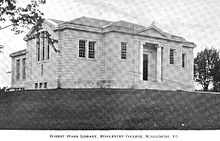
In 1914 and subsequent decades, Middlebury College offered courses in eugenics in fields such as pedagogy, biology, and sociology.[13][14] The college had "extensive involvement in the eugenics movement."[13] The year-long, mandatory "Orientating Course for Freshmen" in 1925 included the subject "Eugenics" and explained that in the previous year this had been taught in this class as "What Has Civilization to Expect from Eugenics."[15] The 1930 Fourth Annual Report of the Eugenics Survey of Vermont noted that Middlebury College President Paul Moody was Chairman of the Committee that supervised the Survey.[16] Middlebury biology supervisor, professor A.E. Lambert lectured outside the college on the "Science of Modern Welfare," based on "heredity and eugenics."[17] Middlebury biology professor Owen Wesley Mills was a member of the Second International Congress of Eugenics.[18]
The national fraternity Kappa Delta Rho was founded in Painter Hall on May 17, 1905. Middlebury College abolished fraternities in the early 1990s, but the organization continued on campus in the less ritualized form of a social house. Due to a policy at the school against single-sex organizations, the house was forced to coeducate during the same period as well.[19] The German Language School, founded in 1915 under the supervision of then-President John Martin Thomas, began the tradition of the Middlebury College Language Schools. These Schools, which take place on campus during the summer, enroll about 1,350 students in the Arabic, Chinese, French, German, Hebrew, Italian, Japanese, Portuguese, Russian, and Spanish Language Schools.[20]
Middlebury President Paul Dwight Moody began the American tradition of a National Christmas Tree in 1923 when the college donated a 48-foot balsam fir for use at the White House.[21] The tree was illuminated when Vermont native Calvin Coolidge flipped an electric switch in the first year of his presidency. The Bread Loaf School of English, Middlebury's graduate school of English, was established at the college's Bread Loaf Mountain campus in 1920.[22] The Bread Loaf Writers' Conference was established in 1926. In 1978, the Bread Loaf School of English expanded to include a campus at Lincoln College, Oxford University. In 1991, the School expanded to include a campus at St. John's College in New Mexico, and to the University of North Carolina, Asheville, in 2006.[22] The C.V. Starr-Middlebury Schools Abroad began in 1949 with the school in Paris; they now host students at 38 sites in Argentina, Brazil, China, Cameroon, Chile, France, Germany, India, Italy, Japan, Jordan, Morocco, Russia, Spain, Uruguay, United Kingdom, and Puerto Rico.[23] The Center for Medieval and Renaissance Studies (CMRS) was founded as an educational charity in 1975 by Drs John and Sandy Feneley in Oxford, England, establishing a facility at St. Michael's Hall in 1978, including the Feneley Library, and close links with Keble College, Oxford; in 2014, CMRS became part of Middlebury College Schools Abroad as Middlebury-CMRS, offering U.S. undergraduates an Oxford Humanities Research Program and Middlebury Museum Studies in Oxford.[24] In 1965, Middlebury established its Environmental Studies program, creating the first undergraduate Environmental Studies program in the U.S.[25] Nationally affiliated fraternities were abolished in 1990; some chose to become co-educational social houses which continue today.[26]
21st century
[edit]
In May 2004, an anonymous benefactor made a $50 million donation to Middlebury.[27] It is the largest cash gift the school has ever received.[28] The donor asked only that Middlebury name its recently built science building, Bicentennial Hall, after outgoing President John McCardell Jr.[27] As of July 2014, Middlebury's endowment stood at approximately $1 billion.[29]
In 2005, Middlebury signed an affiliation agreement with the Monterey Institute of International Studies, a graduate school in Monterey, California. On June 30, 2010, the Monterey Institute was officially designated as a graduate school of Middlebury College.[30]
In the summer of 2008, Middlebury and the Monterey Institute of International Studies launched a collaborative program to offer summer language immersion programs in Arabic, Chinese, French, German, Italian, and Spanish to middle and high school students through the Middlebury-Monterey Language Academy (MMLA). In January 2014, as part of a new brand identity system, Middlebury announced that the Monterey Institute of International Studies would be renamed the Middlebury Institute of International Studies at Monterey.[31]
| External videos | |
|---|---|
On March 2, 2017, political scientist Charles Murray was shouted down by students[32] at a campus event, and prevented from speaking at the McCullough Student Center. Murray had been named a white nationalist by the Southern Poverty Law Center,[33] and has been criticized for a teenaged incident in 1960 where he burned a cross on a hill in his hometown of Newton, Iowa, an act which Murray himself later characterized as "incredibly dumb".[34] After the protest, Murray's talk was moved to Wilson Hall and published online; however, after the talk there was a violent attack by protesters who attempted to obstruct and damage the vehicle of Bill Burger (the Vice President of communications at Middlebury College), Murray, and Middlebury professor Allison Stanger; Stanger was injured in the attack, requiring her hospitalization with a neck injury and concussion.[35][36][37] Middlebury President Laurie L. Patton responded after the event, saying the school would respond to the clear violations of college policy by students that occurred.[38][39] Some students (and faculty[40]) felt that by refusing to allow Murray to speak, and by injuring Stanger, the Middlebury College student community "trod all over the ideas of free speech this country was founded upon".[41] The school took disciplinary action against 74 students for their involvement in the incident.[42][43]
In the spring of 2017, the college also faced allegations of racial profiling, after a student was faced with disciplinary action despite evidence that they had not been present at the protest.[44][45] Middlebury released a statement asserting that such allegations had been investigated that the college had determined that no such racial profiling had taken place. The statement also noted that an investigation had refuted the anonymous allegations against Burger.[46]
Academics
[edit]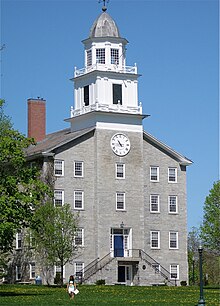
Founded in 1800, the college enrolls approximately 2,500 undergraduates from all 50 states and 70 countries. The college offers 40 undergraduate departments and programs. Middlebury was the first institution of higher education in the United States to offer an environmental studies major, establishing the major in 1965.[25] Middlebury College is accredited by the New England Commission of Higher Education.[47]
The most popular undergraduate majors at Middlebury by number of 2021 graduates were:[48]
- Econometrics & Qualitative Economics (81)
- Computer Science (47)
- Political Science & Government (47)
- Environmental Studies (45)
- Neuroscience (37)
The academic year follows a 4–1–4 schedule of two four-course semesters in the autumn and spring plus what is known as a "Winter Term" session in January. The Winter Term, often called "J-Term" for January Term, allows students to enroll in one intensive course, pursue independent research, or complete an off-campus internship. Winter Term courses are taught by a mix of traditional faculty and special instructors.[49]
Language schools
[edit]The Middlebury College Language Schools, which began with the establishment of the School of German in 1915, offer intensive instruction in 10 languages during six-, seven-, or eight-week summer sessions. The schools enroll about 1,350 students every summer. The Schools all use an immersion-based approach to language instruction and acquisition. All students in the Language Schools must sign and abide by Middlebury's "Language Pledge," a pledge to use their target language exclusively during the duration of their time at the school.[50]
Undergraduate instruction, available to undergraduate students, government employees and individuals from professional backgrounds, is offered in Abenaki, Arabic, Chinese, French, German, Hebrew, Italian, Japanese, Portuguese, Russian, Korean, and Spanish.[51]
Associated programs
[edit]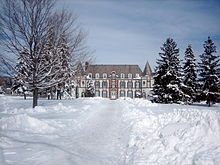
The Middlebury Institute of International Studies at Monterey, in Monterey, California became an affiliate of Middlebury following the signing of an affiliation agreement between the two in December 2005. The Institute currently enrolls 790 graduate students in the fields of international relations, international business, language teaching, and translation and interpretation.
The Middlebury College Language Schools offers a Doctor of Modern Languages. Unique to Middlebury, the D.M.L. prepares teacher-scholars in two modern foreign languages, helping them develop as teachers of second-language acquisition, literature, linguistics, and language pedagogy.[52] Middlebury also offers summer language immersion programs in Arabic, Chinese, French, German, and Spanish to middle and high school students through the Middlebury-Monterey Language Academy.[53]

The Bread Loaf School of English is based at the college's Bread Loaf Mountain campus in Ripton, just outside Middlebury, in sight of the main ridge of the Green Mountains. The poet Robert Frost is credited as a major influence on the school. Frost "first came to the School on the invitation of Dean Wilfred Davison in 1921. Friend and neighbor to Bread Loaf, (he) returned to the School every summer with but three exceptions for 42 years."[54] Every summer since 1920, Bread Loaf has offered students from around the United States and the world intensive courses in literature, creative writing, the teaching of writing, and theater. Many prominent faculty and staff have been associated with the college.[52][54][55]

The C.V. Starr-Middlebury Schools Abroad, operated by Middlebury College in 17 countries across 5 continents, offer overseas academic programs for undergraduates from various U.S. institutions, as well as graduate-level programs for students from Middlebury College's Language Schools and the Monterey Institute of International Studies.[52]
The Rohatyn Center for Global Affairs,[56] was founded by Felix Rohatyn '49, investment banker, former U.S. Ambassador to France, and founder of Rohatyn Associates. Located at the Robert A. Jones '59 House, the center combines Middlebury's strengths in political, linguistic, and cultural studies to offer internationally focused symposia, lectures, and presentations.[57]
The Center for the Comparative Study of Race and Ethnicity[58] engages in interdisciplinary and comparative approaches for understanding formations of race and ethnicity and their effects on human relations.[59] The Center for Social Entrepreneurship[60] encourages students to develop innovative solutions to address society's most pressing social problems.[61][62] Programs on Creativity and Innovation (PCI)[63] is a series of initiatives designed to encourage Middlebury students to explore ideas in nonacademic settings.[64]
Bread Loaf Writers' Conference
[edit]In addition to the six-week summer program, Middlebury College's Bread Loaf campus is also the site of the Bread Loaf Writers' Conference for established authors, founded in 1926. It was called by The New Yorker "the oldest and most prestigious writers' conference in the country."[65] The conference is administered by director Michael Collier and assistant director Jennifer Grotz.[66] Many prominent members of society have been associated with the Writers' Conference.[67]
Reputation and rankings
[edit]| Academic rankings | |
|---|---|
| Liberal arts | |
| U.S. News & World Report[68] | 19 (tie) of 211 |
| Washington Monthly[69] | 19 of 199 |
| National | |
| Forbes[70] | 53 of 500 |
| WSJ/College Pulse[71] | 131 of 600 |
In 2024, U.S. News & World Report ranked Middlebury as tied for 19th out of 211 liberal arts college overall in the U.S.. The previous year, Middlebury tied for 12th out of 36 in "Best Undergraduate Teaching", and 18th out of 93 for "Best Value" among liberal arts colleges for 2023.."[72]
Washington Monthly ranked the school 19th out of 199 in its 2023 liberal arts college rankings.
The 2022 Parchment student choice college ranking, which tracks student college acceptances of students accepted to multiple schools in order to reveal preference for their chosen school compared to other schools, ranks Middlebury as 47th of 1055 colleges.[73]
Admissions
[edit]The Carnegie Foundation classifies Middlebury as a "more selective" institution.[74] For the class of 2026, the college offered admission to 1,955 students out of an applicant pool of 13,028, yielding an overall acceptance of 15%.[75]
Middlebury enrolls around 600 students to begin in the fall semester and an additional 100 to begin in the spring. Those accepted for the fall admissions program begin the academic year in September and are referred to as "Regs." Those accepted for the spring admissions program begin the academic year in February and are referred to as "Febs." Students accepted to the Feb program use the fall semester, called a "Febmester," to travel, volunteer, enroll at other universities, or work.[76] Febs graduate in the annual mid-year commencement at the Middlebury College Snow Bowl.[77]
Tuition, room, and board at Middlebury is $79,800 for the 2022–23 academic year.[78] For the class entering in 2022–23, the average financial aid grant award is $57,078.[79] The college is need-blind for incoming domestic students.[80]
Campus
[edit]The 350-acre (1.4 km2) main campus is located in the Champlain Valley between Vermont's Green Mountains to the east and New York's Adirondack Mountains to the west. The campus is situated on a hill to the west of the village of Middlebury, a traditional New England village centered on Otter Creek Falls.
In the fall of 1994 the President and Board of Trustees of Middlebury College adopted a "One Percent for Art" policy. This decision set aside one percent of the cost of any renovation or new construction at the college for the purchase, installation, maintenance, and interpretation of works of art publicly displayed on campus. There are 19 works in Middlebury's campus public art collection, including Frisbee, George Rickey's Two Open Rectangles, Excentric, Variation VI, Tony Smith's Smog, and a version of Robert Indiana's Love series. The collection also includes works by Dan Graham, Scott Burton, Jules Olitski, Joseph Beuys, Matt Mullican, Jenny Holzer, Christian Petersen, Buky Schwartz, George Rickey, Clement Meadmore, and Jonathan Borofsky.[81]
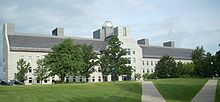
Middlebury College Museum of Art
[edit]The museum opened in the Mahaney Arts Center (named after alumni Kevin P. Mahaney, '84) in 1992, designed by Hardy Holzman Pfeiffer's architectural firm. It was accredited by the American Association of Museums in 2005.[82]
Sustainability
[edit]Middlebury has incorporated environmental stewardship into its mission statement.[83] The college is a signatory to the American College & University Presidents Climate Commitment and the Talloires Declaration. Additionally, the college has committed to be carbon neutral by 2016.[84] Middlebury was one of six universities to receive a grade of "A−" from the Sustainable Endowments Institute on its College Sustainability Report Card 2008, the highest grade awarded.[85]

In 2009, Middlebury opened a state-of-the-art biomass plant on campus that is estimated to cut the college's carbon dioxide output by 40 percent and reduce its use of fuel oil by 50 percent.[86]
In 2010, the Rockefeller Brothers Fund and Middlebury announced the creation of the Sustainable Investments Initiative, a co-mingled fiscal vehicle seeking investments that generate long-term social, environmental, and economic value. The Initiative will seek investments focused on sustainability issues such as clean energy, water, climate science, and green building projects, in an effort to identify businesses positioned to become a part of the worldwide shift to improve energy efficiency, decrease dependence on fossil fuels, and mitigate climate change.[87]
Also in 2010, Middlebury College and Integrated Energy Solutions, a Vermont developer of farm-based methane energy, agreed to explore a bio-methane gas collection and delivery system that could help Middlebury further reduce its use of fossil fuels. Middlebury has agreed to purchase bio-methane gas from IES over a 10-year period, with the agreement contingent on the college raising money to build storage facilities for the gas on campus and retrofit its current heating plant to burn the new fuel.[88]
Student life
[edit]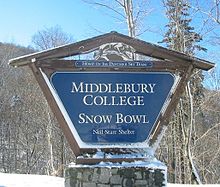
In 2013, Princeton Review ranked Middlebury as one of the top 20 schools in the US for "best quality of life."[89] There are over 140 registered student organizations at Middlebury. Students register for organizations of interest during the Fall Activities Fair in September.[90]
The Middlebury Campus is the student weekly of Middlebury College. The Campus was founded in 1900, and is entirely student-run.[91] In 2019, the Middlebury Independent, a monthly journal, was established.[92][93] The Local Noodle, a satirical student publication founded in 2016, publishes multiple times a semester and maintains a consistent online presence.[94]
WRMC-FM is Middlebury's student-volunteer-run radio station.[95]
Student body
[edit]This section needs expansion. You can help by adding to it. (August 2020) |
The median family income of Middlebury students is $244,300, with 53% of students coming from the top 5% highest-earning families and 14.2% from the bottom 60%.[96] Middlebury College is the ranked 5th in the country for the most share (23%) of students coming from the top 1% of family income ($630,000 or more per year).[97]
As of the 2022-2023 academic year, the student body consisted of 53% women and 47% men. 95% of the student population was from out of state.[98]
| Total Undergraduate | |
|---|---|
| Hispanic/Latino | 331 |
| Black | 149 |
| White, non-Hispanic | 1,547 |
| Asian | 200 |
| American Indian or Alaska Native | 3 |
| Native Hawaiian or Pacific Islander | 0 |
| Nonresidents* | 331 |
| Two or more races | 194 |
| Race and/or ethnicity unknown | 18 |
| TOTAL | 2,773 |
*Nonresidents are reported separately regardless of race/ethnicity
Traditions
[edit]Middlebury's Winter Carnival is the oldest student-run winter carnival in the country, started in 1923.[100] The Winter Carnival is a weekend-long event and traditionally includes a bonfire and fireworks on the opening night, ski races at the Middlebury College Snow Bowl on Friday and Saturday, and the Winter Ball on Saturday night.[101] The Winter Carnival also puts on the Winter Carnival Ice Show, a figure skating event that showcases performances from local kids and teens, Middlebury students, and guest skaters.[102] Notable guests include Swiss Olympian Alexia Paganini in 2016 and Jimmy Ma in 2015.[103]
Middlebury offers a mid-year graduation for those students who complete coursework at the end of January. These students are usually "Febs," students who began their Middlebury careers as February first-years. The mid-year graduation tradition is for all graduating seniors to ski down the Middlebury College Snow Bowl in their caps and gowns to receive their diplomas.[104]
Middlebury Outdoor Programs organizes outdoor orientations for incoming students in September and February. These orientations involve several days of hiking, rock climbing, kayaking, snowshoeing, and other activities in the wilderness around Middlebury.[105]
Following the New Traditions Contest initiated by President Laurie Patton in the spring of 2018, Middlebury held its first Panther Day on October 20, 2018. The new tradition was held during Homecoming Weekend and included a parade of student clubs and organizations, in an effort to build school spirit. A group of student protesters lined the side of the parade route to call attention to the lack of support by the college for survivors of sexual assault.[106]
New England Review
[edit]The New England Review (NER) is a quarterly literary journal published by Middlebury College.
NER publishes poetry, fiction, translations, and a wide variety of non-fiction in each issue. It has published work by many who have gone on to win major awards such as the Pulitzer Prize, the National Book Award, and the National Book Critics Circle Award.[107]

Athletics
[edit]Middlebury competes in the New England Small College Athletic Conference. The Panthers lead the NESCAC in total number of National Championships, having won 33 team championships since the conference lifted its ban on NCAA play in 1994.[108]
In the early 20th century, Middlebury's traditional athletic rivals included the University of Vermont and Norwich University. In football, Middlebury is rivals with Hamilton College; the rivalry dates to 1911 and since 1980 the game between the two schools has been called the "Rocking Chair Classic," with the Mack-Jack Rocking Chair going to the winner (Middlebury has historically dominated the rivalry).[109]
The real-life version of Quidditch was brought to life in 2005 at Middlebury College, by Xander Manshel and Alex Benepe, who later became the first commissioner of quidditch.[110] It has grown into a distinct sport after 15 publications of rulebooks.[111]
Notable people
[edit]This section contains too many pictures for its overall length. (February 2024) |
-
Julia Alvarez
poet, novelist, National Medal of Arts winner, author of How the García Girls Lost Their Accents
AB 1971
Presidents
[edit]- Jeremiah Atwater, 1800–09
- Henry Davis, 1809–18
- Joshua Bates, 1818–40
- Benjamin Labaree, 1840–66
- Harvey Denison Kitchel, 1866–75
- Calvin Butler Hulbert, 1875–80
- Cyrus Hamlin, 1880–85
- Ezra Brainerd, 1885–1908
- John Martin Thomas, 1908–21
- Paul Dwight Moody, 1921–43
- Samuel Somerville Stratton, 1943–63
- James Isbell Armstrong, 1963–75
- Olin Clyde Robison, 1975–90
- Timothy Light, 1990–91
- John McCardell Jr., 1991–2004
- Ronald D. Liebowitz, 2004–15
- Laurie L. Patton, 2015–present
References
[edit]- ^ "Search". Internet Archive.
- ^ As of June 30, 2022. "The Endowment | Middlebury Offices and Services". Middlebury Finance Office. June 30, 2022. Archived from the original on February 28, 2023. Retrieved February 28, 2023.
- ^ "College Navigator". NCES. Fall 2021. Archived from the original on January 16, 2019. Retrieved February 28, 2023.
- ^ "Middlebury College | Middlebury Offices and Services". Middlebury. Fall 2022. Archived from the original on March 27, 2023. Retrieved February 28, 2023.
- ^ "Middlebury Identity Manual" (PDF). Middlebury College. Archived (PDF) from the original on 28 September 2021. Retrieved 28 August 2020.
- ^ a b W.L. Kingsley et al., "The College and the Church," New Englander and Yale Review 11 (Feb 1858): 600. accessed 2010-6-16 Archived 2017-04-13 at the Wayback Machine Note: Middlebury is considered the first "operating" college in Vermont as it was the first to hold classes in November 1800. It issued the first Vermont degree in 1802; University of Vermont followed in 1804.
- ^ "Engineering Options". Middlebury. Archived from the original on 2020-11-24. Retrieved 2021-01-16.
- ^ a b "The College Campus". A Walking History of Middlebury. Archived from the original on 2012-03-02. Retrieved 2012-02-23.
- ^ Firm, Robert (Summer–Fall 2001). "Seth Storrs, Congregationalism, and the Founding of Middlebury College" (PDF). Vermont History. Archived (PDF) from the original on 2012-02-04. Retrieved 2012-02-23.
- ^ Africans in America/Part 2/Lemuel Haynes Archived 2017-08-24 at the Wayback Machine. Pbs.org. Retrieved on 2010-12-23.
- ^ Timeline of Affirmative Action Archived 2012-11-09 at the Wayback Machine. JBHE. Retrieved on 2010-12-23.
- ^ Chellis House | Middlebury Archived 2023-07-05 at the Wayback Machine. Go.middlebury.edu. Retrieved on 2010-12-23.
- ^ a b RACHEL LU (19 July 2023). "A Vermont College Removed the Name of a Eugenicist From Its Campus. Is That Enough?". The Nation. Retrieved 10 August 2023.
its own extensive involvement in the eugenics movement." [...] In a 1914 list published by the Journal of Heredity, Middlebury was among 44 colleges offering courses on eugenics through subjects such as pedagogy, biology, and sociology
- ^ J. Moreno-La Calle, ed. (November 1922). "The Catalogue". Middlebury College Bulletin. XVII (3). Middlebury College: 44.
16. Genetics [...] Mendelian inheritance and the application of its principles in animal and plant breeding and eugenics
- ^ Julius S. Kingsley; Garner Williams (July 1925). Moreno-La Calle, J. (ed.). "An Outline for an Orientating Course for Freshmen". Middlebury College Bulletin. XX (1): 6, 13–16. Retrieved 10 August 2023.
4. THE WEEKLY LECTURES [...] Among the topies treated during the past year during the lecture period were: How to Read and Study; What Has Civilization to Expect from Eugenics [...] 9. ILLUSTRATIVE EXPANSION OF SOME OF THE PROBLEMS [...] Variation and Mutation. Eugenics. Enzymes. Vitamins.
- ^ "Foreword". Fourth Annual Report of the Eugenics Survey of Vermont. Auspices of the University of Vermont. March 1930. p. 3. Retrieved 10 August 2023.
Eugenics Survey of Vermont has been cooperating as fully as possible under the general supervision of the Committee on the Human Factor of which President Paul Moody of Middlebury College is Chairman
- ^ "Strong Advocate of Eugenic Marriages". Rutland Herald (Rutland Daily Herald). 5 January 1916. Retrieved 11 August 2023.
on the "Science of Modern Welfare." The address was based on heredity and eugenics. Prof. Lambert is supervisor of biology at the college.
- ^ "Professor of Biology". Barre Montpelier Times Argus (The Barre Daily Times). 8 December 1924. p. 7. Retrieved 11 August 2023.
Owen Wesley Mills, professor of biology at Middlebury college [… was ...] a member of the second International Congress of Eugenics
- ^ "National Fraternity of Kappa Delta Rho". Archived from the original on 10 March 2016. Retrieved 7 December 2016.
- ^ "Hebrew Program at Middlebury – Intensive Hebrew Summer Program". Archived from the original on 24 October 2016. Retrieved 7 December 2016.
- ^ National Park Service, 1923 National Christmas Tree Archived 2012-01-29 at the Wayback Machine (December 23, 2010.)
- ^ a b "Bread Loaf's History". Middlebury. Archived from the original on 11 December 2016. Retrieved 7 December 2016.
- ^ "Middlebury Schools Abroad". Middlebury. Archived from the original on 10 February 2015. Retrieved 7 December 2016.
- ^ "About Middlebury-CMRS". Middlebury College CRS Oxford Humanities Research Program. Archived from the original on 2017-10-15. Retrieved 2017-10-14.
- ^ a b "About the Program". Middlebury. Archived from the original on 2 February 2017. Retrieved 7 December 2016.
- ^ "Fraternities Go Underground to Defy College Ban". The New York Times. 1994-08-29. Archived from the original on 2017-03-24. Retrieved 2017-02-17.
- ^ a b Flagg, Kathryn (October 13, 2005). "College targets alumni donors Middlebury strives to meet challenges of $50M gift". The Middlebury Campus. Archived from the original on September 25, 2015. Retrieved September 24, 2015.
- ^ "Middlebury College Gets $60 Million in Gifts". Los Angeles Times. May 7, 2004. Archived from the original on September 25, 2015. Retrieved September 24, 2015.
- ^ Middlebury College Presidential Search Statement Archived 2014-07-14 at the Wayback Machine.
- ^ "The Power of M2: Integrating the Monterey Institute of International Studies and Middlebury College" (PDF). Middlebury College. 2010. Archived (PDF) from the original on 2012-03-08. Retrieved 2012-02-23.
- ^ "Middlebury Launches New Brand Identity System | Middlebury". Middlebury.edu. 2015-01-07. Archived from the original on 2015-12-23. Retrieved 2015-12-20.
- ^ Greenberg, Emily (3 March 2017). "MIDDLEBURY COLLEGE STUDENTS BLOCK CONTROVERSIAL SPEAKER". VTDigger.org. Archived from the original on 15 March 2017. Retrieved 8 May 2017.
- ^ "Charles Murray". Southern Poverty Law Center. Archived from the original on 2019-03-06. Retrieved 2019-03-08.
- ^ Herbert, Bob (1994-10-26). "In America; Throwing a Curve". The New York Times. ISSN 0362-4331. Archived from the original on 2018-12-13. Retrieved 2019-03-08.
- ^ Stanger, Allison (13 March 2017). "Understanding the Angry Mob at Middlebury That Gave Me a Concussion". The New York Times. Archived from the original on 12 January 2021. Retrieved 20 March 2017.
- ^ Jaschik, Scott (6 March 2017). "The Aftermath at Middlebury: Middlebury engages in soul-searching after speech is shouted down and professor is attacked". insidehighered.com. Archived from the original on 6 March 2017. Retrieved 7 March 2017.
- ^ Hallenbeck, Brent (March 3, 2017). "Protesters created 'violent incident' at Middlebury". Burlington Free Press. Archived from the original on July 19, 2022. Retrieved March 5, 2017.
- ^ "Statement from President Laurie L. Patton Regarding Charles Murray Event". Middlebury College. March 3, 2017. Archived from the original on July 19, 2022. Retrieved March 4, 2017.
- ^ Staff writers (March 3, 2017). "Middlebury College professor injured by protesters as she escorted controversial speaker". Addison County Independent. Addison County, Vermont. Archived from the original on 3 March 2017. Retrieved 4 March 2017.
- ^ Anzali, Ata (9 March 2017). "A Sad Day on Campus". The Middlebury Campus. Archived from the original on 21 March 2017. Retrieved 20 March 2017.
As I sat in McCullough Student Center, unsuccessfully trying to watch the live stream of Murray's speech in the middle of student protests, fire alarms going on and off and the live stream being cut off, I saw the frozen face of a man with whom I deeply, and fundamentally, disagreed. As events unfolded, however, I could think less and less about my disagreements with him and more and more about how much the student protesters — who could afford to ignore President Patton and Professor Stanger's open and strong invitation for civic engagement and rhetorical resilience — took the tremendous amount of freedom that they had for granted. A freedom that, even after the loss of thousands of precious lives in its pursuit, still looks like a distant dream in many countries across the globe.
- ^ Smith, Charles (9 March 2017). "Charles Murray, Middlebury, the Working Class and the Rise of Trump's America". The Middlebury Campus. Archived from the original on 20 March 2017. Retrieved 20 March 2017.
- ^ "Middlebury College Completes Sanctioning Process for March 2 Disruptions". Middlebury College. 2017-05-23. Archived from the original on 2017-05-25. Retrieved 2017-05-25.
- ^ Reilly, Katie (May 24, 2017). "Middlebury Has Sanctioned Students for Shutting Down Charles Murray's Lecture". Time. Archived from the original on May 24, 2017. Retrieved May 24, 2017.
- ^ BRADY, ETHAN. "Accused Student Alleges Racial Profiling". The Middlebury Campus. Archived from the original on 2018-05-25. Retrieved 2019-03-08.
- ^ "Letter: Racial Profiling by Public Safety". The Middlebury Campus. Archived from the original on 2021-09-24. Retrieved 2019-03-08.
- ^ "Middlebury Statement on "Profiling" Investigation". Middlebury. 2017-11-06. Archived from the original on 2018-11-27. Retrieved 2019-03-08.
- ^ Vermont Institutions – NECHE, New England Commission of Higher Education, archived from the original on June 18, 2021, retrieved May 26, 2021
- ^ "Middlebury College". nces.ed.gov. U.S. Dept of Education. Archived from the original on January 16, 2019. Retrieved February 14, 2023.
- ^ "The 4-1-4 Calendar Year and Winter Term". Archived from the original on 2015-12-22. Retrieved 2015-12-18.
- ^ "Language Pledge". Middlebury. Archived from the original on 2 March 2015. Retrieved 7 December 2016.
- ^ "Middlebury Language Schools – Intensive Summer Programs". Middlebury. Archived from the original on 12 December 2016. Retrieved 7 December 2016.
- ^ a b c "Graduate Programs in Language Instruction". Middlebury. Archived from the original on 7 December 2016. Retrieved 7 December 2016.
- ^ Middlebury-Monterey Language Academy Archived 2012-01-21 at the Wayback Machine. Mmla.middlebury.edu. Retrieved on 2014-2-12.
- ^ a b "Bread Loaf History". Archived from the original on October 21, 2008. Retrieved 2006-04-06.
{{cite web}}: CS1 maint: bot: original URL status unknown (link) - ^ Robert Frost at Bread Loaf Archived 2006-05-08 at the Wayback Machine. Midddigital.middlebury.edu. Retrieved on 2010-12-23.
- ^ Rohatyn Center for Global Affairs | Middlebury Archived 2011-01-01 at the Wayback Machine. Middlebury.edu. Retrieved on 2010-12-23.
- ^ "Mission". Middlebury. Archived from the original on 28 October 2012. Retrieved 7 December 2016.
- ^ Center for the Comparative Study of Race and Ethnicity | Middlebury Archived 2011-01-02 at the Wayback Machine. Middlebury.edu (2010-12-03). Retrieved on 2010-12-23.
- ^ "Center for the Comparative Study of Race and Ethnicity". Middlebury. Archived from the original on 18 November 2016. Retrieved 7 December 2016.
- ^ Center for Social Entrepreneurship | Middlebury Archived 2015-08-18 at the Wayback Machine. Middlebury.edu (2015-07-27). Retrieved on 2015-07-27.
- ^ [1] Archived 2015-08-12 at the Wayback Machine Ashoka – Innovators for the Public. Ashoka.org (2015-07-27). Retrieved on 2015-07-27.
- ^ "Vision Award". 11 April 2013. Archived from the original on 25 September 2016. Retrieved 7 December 2016.
- ^ Programs on Creativity and Innovation | Middlebury Archived 2015-08-17 at the Wayback Machine. Middlebury.edu (2015-07-27). Retrieved on 2015-07-27.
- ^ Programs | PCI at Middlebury Archived 2015-06-18 at the Wayback Machine. Middlebury.edu (2015-07-27). Retrieved on 2015-07-27.
- ^ "Laila Lalami » Blog Archive » Bread Loaf Diaries". Archived from the original on 14 March 2016. Retrieved 7 December 2016.
- ^ "Middlebury College > Bread Loaf Writer's Conference > Contact Us". Archived from the original on July 18, 2009.
- ^ "Faculty & Guests | Middlebury". Archived from the original on 2011-10-31. Retrieved 2011-04-08. Bread Loaf Writers' Conference Faculty, Guests, Staff
- ^ "2024-2025 National Liberal Arts Colleges Rankings". U.S. News & World Report. September 23, 2024. Retrieved November 22, 2024.
- ^ "2024 Liberal Arts Colleges Rankings". Washington Monthly. August 25, 2024. Retrieved August 29, 2024.
- ^ "America's Top Colleges 2024". Forbes. September 6, 2024. Retrieved September 10, 2024.
- ^ "2025 Best Colleges in the U.S." The Wall Street Journal/College Pulse. September 4, 2024. Retrieved September 6, 2024.
- ^ "Middlebury College Rankings". U.S. News & World Report. 2023. Archived from the original on 2020-09-06. Retrieved 2023-12-03.
- ^ "Parchment Student Choice College Rankings 2022 | Parchment - College admissions predictions". www.parchment.com. Archived from the original on 2023-04-05. Retrieved 2023-04-05.
- ^ "Middlebury College Carnegie Foundation". Archived from the original on 2018-09-14. Retrieved 2018-09-14.
- ^ "Middlebury Admits Students to the Class of 2026 from Record-Breaking Applicant Pool". Middlebury. 2022-04-01. Archived from the original on 2019-09-03. Retrieved 2023-01-22.
- ^ "Febmester Resources | Middlebury College". www.middlebury.edu. Archived from the original on 2021-11-12. Retrieved 2021-11-12.
- ^ "For February Admissions". Middlebury College. Archived from the original on 2012-04-02. Retrieved 2012-02-24.
- ^ Anonymous (23 March 2022). "Middlebury College Sets Fee for 2022–2023 | Middlebury News and Announcements". www.middlebury.edu. Archived from the original on 2023-04-05. Retrieved 2023-04-05.
- ^ "Apply to Middlebury College | Middlebury College". www.middlebury.edu. Archived from the original on 2020-04-24. Retrieved 2023-04-05.
- ^ "Affording Middlebury". Middlebury College. Archived from the original on 3 May 2023. Retrieved 3 May 2023.
- ^ "Public Art on Campus". Archived from the original on 2010-05-28. Retrieved 2010-05-25.
- ^ "History". Middlebury College Museum of Art. Archived from the original on 2014-02-02. Retrieved 2014-01-30.
- ^ "Middlebury College Mission Statement". Middlebury College. Archived from the original on 2007-12-24. Retrieved 2008-05-21.
- ^ "Middlebury's commitment to carbon neutrality". Middlebury College. Archived from the original on 2007-12-27. Retrieved 2008-05-21.
- ^ "College Sustainability Report Card 2008". Sustainable Endowments Institute. Archived from the original on 2008-07-17. Retrieved 2008-05-21.
- ^ "Biomass at Middlebury ·". Archived from the original on 2023-04-05. Retrieved 2023-04-05.
- ^ "Middlebury and Rockefeller Brothers Fund Sustainable Investments Initiative". Archived from the original on 2010-05-28. Retrieved 2010-06-01.
- ^ "Middlebury and IES Bio-Methane Agreement". Archived from the original on 2010-05-29. Retrieved 2010-06-01.
- ^ [2] Archived 2015-08-17 at the Wayback Machine. Princetonreview.com (2015). Retrieved on 2015-08-16.
- ^ "MiddLink – Organizations". Middlebury. Archived from the original on 22 April 2017. Retrieved 7 December 2016.
- ^ "About". 3 September 2012. Archived from the original on 24 October 2016. Retrieved 7 December 2016.
- ^ "About Us". Middlebury Independent. 2019-08-19. Archived from the original on 2019-10-18. Retrieved 2019-10-18.
- ^ ASCH, SARAH. "Students launch new publication Middlebury Independent". The Middlebury Campus. Archived from the original on 2019-10-18. Retrieved 2019-10-18.
- ^ Laesch, Lily (February 20, 2020). "Comic relief in the time of controversy". The Middlebury Campus. Archived from the original on 2020-03-01. Retrieved 2020-05-26.
- ^ "About | WRMC 91.1 FM". Archived from the original on 2023-04-05. Retrieved 2023-04-05.
- ^ Aisch, Gregor; Buchanan, Larry; Cox, Amanda; Quealy, Kevin (18 January 2017). "Economic diversity and student outcomes at Middlebury". The New York Times. Archived from the original on 7 October 2020. Retrieved 9 August 2020.
- ^ "Economic diversity and student outcomes at Middlebury". The New York Times. 18 January 2017.
- ^ "Assessment and Institutional Research Historical Data". Middlebury College. 2023.
- ^ "Historical Data | Middlebury". www.middlebury.edu. Retrieved 2024-09-27.
- ^ "MCAB Traditions".[permanent dead link]
- ^ "Winter Carnival". Archived from the original on August 16, 2010.
- ^ "Ice Show". Middlebury Figure Skating. 2023-02-02. Retrieved 2024-09-25.
- ^ "Middlebury College's Ice Show | A Middlebury blog". sites.middlebury.edu. Retrieved 2024-09-25.
- ^ "February Graduation". Archived from the original on 18 November 2016. Retrieved 7 December 2016.
- ^ "Middlebury Outdoor Programs". Archived from the original on February 8, 2011.
- ^ PATCH, EMMA, Panther Day: Midd in Two Forms, archived from the original on 2018-11-07, retrieved 2019-03-08
- ^ New England Review Archived 2023-07-05 at the Wayback Machine. Go.middlebury.edu. Retrieved on 2010-12-23.
- ^ "Burlington Free Press.com | Sports".[permanent dead link]
- ^ Beck, Stan; Wilkinson, Jack (2013). College Sports Traditions: Picking Up Butch, Silent Night, and Hundreds of Others. Scare Crow Press. p. 282. ISBN 978-0810891210.
- ^ Plummer, Willis (4 August 2011). "Alex Benepe, Quidditch Commissioner, On the Upcoming Quidditch World Cup". Archived from the original on 2015-09-30. Retrieved 2015-09-29.
- ^ "Rules | US Quidditch". US Quidditch. Archived from the original on October 25, 2021. Retrieved October 25, 2021.
 KSF
KSF